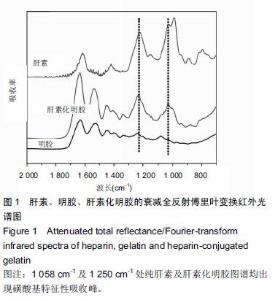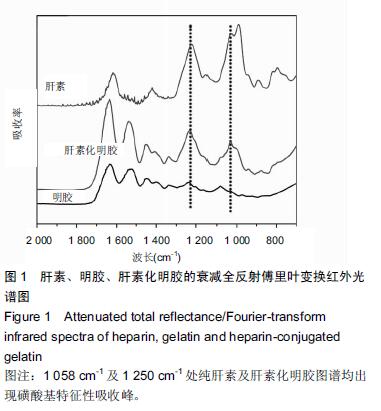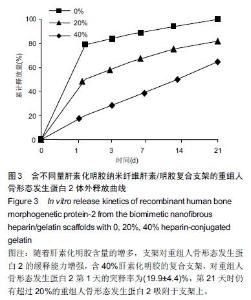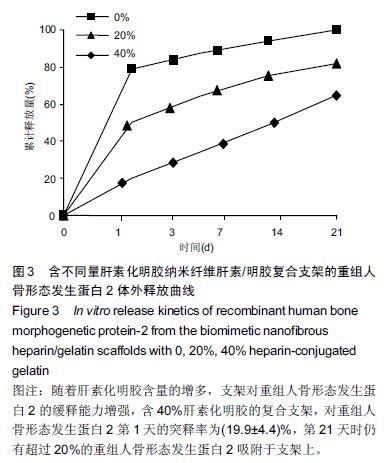Chinese Journal of Tissue Engineering Research ›› 2016, Vol. 20 ›› Issue (16): 2384-2390.doi: 10.3969/j.issn.2095-4344.2016.16.014
Previous Articles Next Articles
A novel biomimetic nanofibrous heparin/gelatin scaffold with sustained-release recombinant human bone morphogenetic protein-2: preparation and characterization
Ding Chen, Liu Hao
- Department of Orthopedic Surgery, West China Hospital, Sichuan University, Chengdu 610041, Sichuan Province, China
-
Received:2016-03-08Online:2016-04-15Published:2016-04-15 -
Contact:Liu Hao, M.D., Doctoral supervisor, Department of Orthopedic Surgery, West China Hospital, Sichuan University, Chengdu 610041, Sichuan Province, China -
About author:Ding Chen, M.D., Attending physician, Department of Orthopedic Surgery, West China Hospital, Sichuan University, Chengdu 610041, Sichuan Province, China -
Supported by:the National Natural Science Foundation of China, No. 81572141
Cite this article
Ding Chen, Liu Hao. A novel biomimetic nanofibrous heparin/gelatin scaffold with sustained-release recombinant human bone morphogenetic protein-2: preparation and characterization[J]. Chinese Journal of Tissue Engineering Research, 2016, 20(16): 2384-2390.
share this article
|
[1] Xu B,Xu H,Wu Y,et al.Intervertebral disc tissue engineering with natural extracellular matrix-derived biphasic composite scaffolds.PLoS One.2015;10(4): e0124774. [2] 马新芳,张静莹.骨组织工程支架材料的研究现状与应用前景[J].中国组织工程研究,2014, 18(30):4895-4899. [3] Holzwarth JM, Ma PX.Biomimetic nanofibrous scaffolds for bone tissue engineering. Biomaterials. 2011;32(26):9622-9629. [4] Ruiz-Hitzky E,Darder M,Aranda P,et al.Advances in biomimetic and nanostructured biohybrid materials. Adv Mater.2010;22(3):323-326. [5] Xie J,Peng C,Zhao Q,et al.Osteogenic differentiation and bone regeneration of iPSC-MSCs supported by a biomimeticnanofibrous scaffold.Acta Biomater.2016;29: 365-379. [6] Qu T,Liu X.Nano-structured gelatin/bioactive glass hybrid scaffolds for the enhancement of odontogenic differentiation of human dental pulp stem cells.J Mater Chem B Mater Biol Med.2013;1(37):4764-4772. [7] Liu X,Ma PX.Phase separation, pore structure, and properties of nanofibrous gelatin scaffolds. Biomaterials. 2009;30(25):4094-4103. [8] Liu X,Smith LA,Hu J,et al.Biomimetic nanofibrous gelatin/apatite composite scaffolds for bone tissue engineering.Biomaterials.2009;30(12):2252-2258. [9] Rey-Rico A,Silva M,Couceiro J,et al.Osteogenic efficiency of in situ gelling poloxamine systems with and without bone morphogenetic protein-2. Eur Cell Mater.2011; 21(4):317-340. [10] Lieberman JR,Daluiski A,Einhorn TA.The role of growth factors in the repair of bone. Biology and clinical applications.J Bone Joint Surg Am. 2002; 84-A(6):1032-1044. [11] Bouxsein ML,Turek TJ,Blake CA,et al.Recombinant human bone morphogenetic protein-2 accelerates healing in a rabbit ulnar osteotomy model.J Bone Joint Surg Am.2001; 83-A(8): 1219-1230. [12] Vo TN,Kasper FK,Mikos AG,et al.Strategies for controlled delivery of growth factors and cells for bone regeneration.Adv Drug Deliv Rev. 2012;64(12):1292- 1309. [13] 马立坤,叶鹏,黄文良,等.骨形态发生蛋白2/聚乳酸缓释微球的制备及表征[J].中国组织工程研究, 2014,18(3): 395-400. [14] 王玮,尹庆水,张余.负载重组人骨形态发生蛋白-2壳聚糖纳米微球的制备及异位成骨活性研究[J].中华创伤骨科杂志,2012,14(2):147-152. [15] Carreira AC,Lojudice FH,Halcsik E,et al.Bone morphogenetic proteins: facts, challenges, and future perspectives.J Dent Res.2014;93(4):335-345. [16] Lee J,Yoo JJ,Atala A,et al.The effect of controlled release of PDGF-BB from heparin-conjugated electrospun PCL/gelatin scaffolds on cellular bioactivity and infiltration.Biomaterials.2012;33(28):6709-6720. [17] Seib FP, Herklotz M, Burke KA, et al. Multifunctional silk-heparin biomaterials for vascular tissue engineering applications.Biomaterials. 2014;35(1): 83-91. [18] Zuo Q,Guo R,Liu Q,et al.Heparin-conjugated alginate multilayered microspheres for controlled release of bFGF. Biomed Mater.2015;10(3):035008. [19] Lu Q,Li M,Zou Y,et al. Delivery of basic fibroblast growth factors from heparinized decellularized adipose tissue stimulates potent de novo adipogenesis.J Control Release. 2014;174:43-50. [20] Bhakta G,Rai B,Lim ZX,et al.Hyaluronic acid-based hydrogels functionalized with heparin that support controlled release of bioactive BMP-2. Biomaterials. 2012;33(26): 6113-6122. [21] 刘秀英,张超灿,徐卫林,等.甲苯胺蓝分光光度法测定肝素钠的研究[J].化学试剂,2009, 31(4):271-274. [22] Lin H,Zhao Y,Sun W,et al.The effect of crosslinking heparin to demineralized bone matrix on mechanical strength and specific binding to human bone morphogenetic protein-2. Biomaterials. 2008;29(9): 1189-1197. [23] Karageorgiou V,Kaplan D.Porosity 3D biomaterial scaffolds and osteogenesis. Biomaterials. 2005;26(27): 5474-5491. [24] Banwart JC,Asher MA,Hassanein RS.Iliac crest bone graft harvest donor site morbidity. A statistical evaluation. Spine (Phila Pa 1976).1995;20(9): 1055-1060. [25] Florczyk SJ,Leung M,Li Z,et al.Evaluation of three-dimensional porous chitosan–alginate scaffolds in rat calvarial defects for bone regeneration applications. J Biomed Mater Res. 2013;101(10): 2974-2983. [26] De Long Jr WG,Einhorn TA,Koval K,et al.Bone grafts and bone graft substitutes in orthopaedic trauma surgery. A critical analysis.J Bone Joint Surg A. 2007; 89(3): 649-658. [27] Xiao W,Fu H,Rahaman MN,et al.Hollow hydroxyapatite microspheres: a novel bioactive and osteoconductive carrier for controlled release of bone morphogenetic protein-2 in bone regeneration.Acta Biomater. 2013; 9(9): 8374-8383. [28] Hollister SJ. Porous scaffold design for tissue engineering. Nat Mater.2005;4(7): 518-524. [29] Bueno EM,Glowacki J.Cell-free and cell-based approaches for bone regeneration. Nat Rev Rheumatol. 2009;5(12):685-697. [30] 谢兴文,姜徽,李宁,等.重组人骨形态发生蛋白2诱导骨修复的应用及前景[J].中国组织工程研究, 2013,17(7): 1319-1323. [31] Galimberti F,Lubelski D,Healy AT,et al.A systematic review of lumbar fusion rates with and without the use of rhBMP-2.Spine (Phila Pa 1976). 2015;40(14):1132-1139. [32] Zhao B,Katagiri T,Toyoda H,et al.Heparin potentiates the in vivo ectopic bone formation induced by bone morphogenetic protein-2.J Biol Chem.2006;281(32): 23246-23253. [33] Li Z,Qu T,Ding C,et al.Injectable gelatin derivative hydrogels with sustained vascular endothelial growth factor release for induced angiogenesis.Acta Biomater. 2015;13:88-100. [34] 李娟,吴英锋,杨新林.肝素功能化生物材料的研究进展[J].有机化学,2010,30(3):359-367. [35] 马寅孙,蔡玉荣,刘琳,等.肝素化丝素支架作为骨形态发生蛋白-2缓释载体的研究[J].化学学报,2012, 70(4): 479-484. [36] Jeon O,Song SJ,Kang SW,et al.Enhancement of ectopic bone formation by bone morphogenetic protein-2 released from a heparin-conjugated poly(L-lactic-co-glycolic acid) scaffold.Biomaterials. 2007;28(17):2763-2771. [37] Xu X,Jha AK,Duncan RL,et al.Heparin-decorated, hyaluronic acid-based hydrogel particles for the controlled elease of bone morphogenetic protein 2.Acta Biomater.2011; 7(8):3050-3059. [38] Sachar A,Strom TA,Serrano MJ,et al.Osteoblasts responses to three-dimensional nanofibrous gelatin scaffolds.J Biomed Mater Res A. 2012;100(11): 3029-3041. [39] Sun Y,Jiang Y,Liu Q,et al.Biomimetic Engineering of Nanofibrous Gelatin Scaffolds with Noncollagenous Proteins for Enhanced Bone Regeneration.Tissue Eng Part A.2013; 19(15-16):1754-1763. [40] Ma PX,Zhang R.Synthetic nano-scale fibrous extracellular matrix. J Biomed Mater Res. 1999;46(1):60-72. |
| [1] | Zhang Tongtong, Wang Zhonghua, Wen Jie, Song Yuxin, Liu Lin. Application of three-dimensional printing model in surgical resection and reconstruction of cervical tumor [J]. Chinese Journal of Tissue Engineering Research, 2021, 25(9): 1335-1339. |
| [2] | Zeng Yanhua, Hao Yanlei. In vitro culture and purification of Schwann cells: a systematic review [J]. Chinese Journal of Tissue Engineering Research, 2021, 25(7): 1135-1141. |
| [3] | Xu Dongzi, Zhang Ting, Ouyang Zhaolian. The global competitive situation of cardiac tissue engineering based on patent analysis [J]. Chinese Journal of Tissue Engineering Research, 2021, 25(5): 807-812. |
| [4] | Wu Zijian, Hu Zhaoduan, Xie Youqiong, Wang Feng, Li Jia, Li Bocun, Cai Guowei, Peng Rui. Three-dimensional printing technology and bone tissue engineering research: literature metrology and visual analysis of research hotspots [J]. Chinese Journal of Tissue Engineering Research, 2021, 25(4): 564-569. |
| [5] | Chang Wenliao, Zhao Jie, Sun Xiaoliang, Wang Kun, Wu Guofeng, Zhou Jian, Li Shuxiang, Sun Han. Material selection, theoretical design and biomimetic function of artificial periosteum [J]. Chinese Journal of Tissue Engineering Research, 2021, 25(4): 600-606. |
| [6] | Liu Fei, Cui Yutao, Liu He. Advantages and problems of local antibiotic delivery system in the treatment of osteomyelitis [J]. Chinese Journal of Tissue Engineering Research, 2021, 25(4): 614-620. |
| [7] | Li Xiaozhuang, Duan Hao, Wang Weizhou, Tang Zhihong, Wang Yanghao, He Fei. Application of bone tissue engineering materials in the treatment of bone defect diseases in vivo [J]. Chinese Journal of Tissue Engineering Research, 2021, 25(4): 626-631. |
| [8] | Zhang Zhenkun, Li Zhe, Li Ya, Wang Yingying, Wang Yaping, Zhou Xinkui, Ma Shanshan, Guan Fangxia. Application of alginate based hydrogels/dressings in wound healing: sustained, dynamic and sequential release [J]. Chinese Journal of Tissue Engineering Research, 2021, 25(4): 638-643. |
| [9] | Chen Jiana, Qiu Yanling, Nie Minhai, Liu Xuqian. Tissue engineering scaffolds in repairing oral and maxillofacial soft tissue defects [J]. Chinese Journal of Tissue Engineering Research, 2021, 25(4): 644-650. |
| [10] | Xing Hao, Zhang Yonghong, Wang Dong. Advantages and disadvantages of repairing large-segment bone defect [J]. Chinese Journal of Tissue Engineering Research, 2021, 25(3): 426-430. |
| [11] | Wang Hao, Chen Mingxue, Li Junkang, Luo Xujiang, Peng Liqing, Li Huo, Huang Bo, Tian Guangzhao, Liu Shuyun, Sui Xiang, Huang Jingxiang, Guo Quanyi, Lu Xiaobo. Decellularized porcine skin matrix for tissue-engineered meniscus scaffold [J]. Chinese Journal of Tissue Engineering Research, 2021, 25(22): 3473-3478. |
| [12] | Mo Jianling, He Shaoru, Feng Bowen, Jian Minqiao, Zhang Xiaohui, Liu Caisheng, Liang Yijing, Liu Yumei, Chen Liang, Zhou Haiyu, Liu Yanhui. Forming prevascularized cell sheets and the expression of angiogenesis-related factors [J]. Chinese Journal of Tissue Engineering Research, 2021, 25(22): 3479-3486. |
| [13] | Liu Chang, Li Datong, Liu Yuan, Kong Lingbo, Guo Rui, Yang Lixue, Hao Dingjun, He Baorong. Poor efficacy after vertebral augmentation surgery of acute symptomatic thoracolumbar osteoporotic compression fracture: relationship with bone cement, bone mineral density, and adjacent fractures [J]. Chinese Journal of Tissue Engineering Research, 2021, 25(22): 3510-3516. |
| [14] | Liu Liyong, Zhou Lei. Research and development status and development trend of hydrogel in tissue engineering based on patent information [J]. Chinese Journal of Tissue Engineering Research, 2021, 25(22): 3527-3533. |
| [15] | Bi Qingwei, Liu Chengpu, Li Yan, Zhao Wenwen, Han Mei. Structure analysis of platelet-rich fibrin derived from two centrifugation procedures [J]. Chinese Journal of Tissue Engineering Research, 2021, 25(22): 3534-3539. |
| Viewed | ||||||
|
Full text |
|
|||||
|
Abstract |
|
|||||





